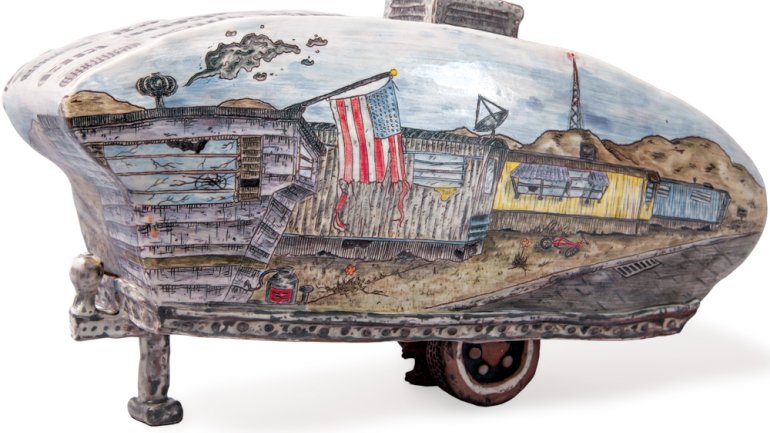Richard Peterson
Richard Peterson
Richard Peterson’s ceramics tell stories about contemporary American life – ones we don’t always hear.
Using underglaze paints or screenprinting, along with carving and inlay techniques, he covers his clay forms with drawings, in a twisted, cartoon style reminiscent of Mad magazine or R. Crumb. While the dark humor pulls us in, the images can be hard to look at.
Take his small sculpture Home Sweet Home (2014), with surface illustrations of a meth lab, a mattress stained with urine, a body apparently dead from an overdose – and a child holding a needle. He made the piece thinking about the cycles of addiction, “where children are born into this environment that envelops them.”
For Peterson, it’s personal. “Most of the narratives I’ve been creating are autobiographical to an extent, but they’re no longer just about me,” says the artist, 26. He grew up poor in a small town in Ohio, and saw the toll drugs and alcohol took on family and friends. Now his work calls attention to these and other social ills, how they affect young lives. He’s also done a series about polluted waters – another kind of toxic environment – featuring images of bizarre mutant fish.
Toys figure poignantly in his domestic scenes. We see an overturned plastic kiddie car, a bicycle with a flat tire, beer cans littering the ground. I Had My First Birthday Party With Friends Here (2015) depicts the trailer Peterson lived in as a child. His toy monster truck and his brother’s Power Wheels are in the yard, and a basketball sits on the roof where his sister always managed to toss it. “There were a lot of good memories there and a lot of terrible memories,” he says. “But we were a family there, and there’s something really beautiful in that.”
Art and education helped Peterson survive and transcend his difficult childhood. Drawing was always his refuge, a means of coping with the dysfunction around him. After discovering clay in high school, he decided to pursue a degree in ceramic art and got a scholarship to attend the University of Akron. While still a student, he quickly made a name for himself producing his illustrated cups, bowls, and plates under the moniker Rich the Potter. Since starting graduate school recently at the University of Arkansas, however, he’s been rethinking his approach.
“I’ve changed where I live. I’m changing the way I think about my medium. I’m changing my focus, trying to grow as an artist and an individual,” he says. While the potter in him still loves the vessel, the emerging sculptor wants to take it further, “to enhance the narrative with form.”
By making art that gives voice to those whom society neglects, looks down on, or simply doesn’t see, he hopes to stir some empathy – and perhaps, somehow, action.
“Maybe I won’t ever make a difference, but I can start a conversation,” he says. “What I’m really saying is the epidemic of addiction – and even domestic violence, sexism, racism, all of those things – can change with one generation. But how do we get to that point of education? I think a lot of it starts with care and compassion.”
Joyce Lovelace is American Craft’s contributing editor.

